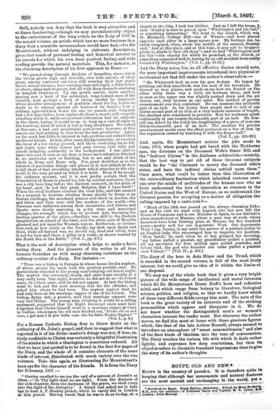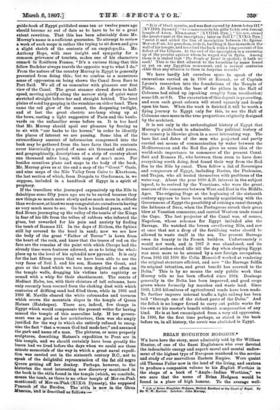EGYPT, OLD AND NEW.* EGYPT is the country of paradox.
It is therefore quite in keeping that although her monuments and natural features are the most ancient and unchanging in the world, yet a • Handbook for $ppt. Plinth Edition, sswtittan. gated by Mary.Brodria. &D., with the aaawtenc i of Professor Owe end 0.epteiti R. G. Lions; 71.3.
Louden: John lturray. : : .
guide-book of Egypt published some ten or twelve years ago should become so out of date as to have to be to a great extent rewritten. That this has been admirably done Mr. Murray's name is a sufficient guarantee. To attempt to review a work of such scope is rather like trying to sit down and give a slight sketch of the contents of an encyclopmdia. Mr. Anthony Hope, with rare insight and sympathy for a common grievance of tourists, makes one of his characters remark in Southern France, "It's a curious thing that this fellow BmIelrer always travels the opposite way to what I do." From the nature of the country Murray in Egypt is generally prevented from doing this ; but we confess to a monstrous sense of oppression on being shown the Canal from Suez to Port Said. We all of us remember with pleasure our first view of the Canal. The great steamer slowed down to half- speed, moving quietly along the narrow strip of quiet water stretched straight before her and straight behind. The level plains of sand lay gasping in the sunshine on either hand. Then came the red glow of the sunset, the deepening twilight, and at last the great electric arc-lamp slung up at the bows, casting a light suggestive of Paris and the boule- vards on the unfamiliar scene before us. It is too hard that Mr. Murray should spoil our pleasure by forcing us to sit with "our backs to the horses," in order to identify the places of interest we are passing. Some idea of the extraordinary amount of information compressed into the book may be gathered from the bare facts that its contents cover historically a period of some six thousand odd years, and geographically, descriptions of a strip of country about one thousand miles long, with maps of much more. For besides countless plans and maps in the body of the book, Mr. Murray gives us at the end a map of the " Great" Oasis, and nine maps of the Nile Valley from Cairo to Khartoum, the last section of which, from Dongola to Omdurman, is, we suppose, included in a handbook of Egypt in a spirit of prophecy.
If the travellers who journeyed expensively up the Nile in dahabiyas some fifty years ago are to be envied because they saw things so much more slowly and so much more in solitude than we do now, at least we may congratulate ourselves in having so very much more to see. Go back a hundred years, and we find Bruce journeying up the valley of the tombs of the Kings in fear of his life from the tribes of robbers who infested the place, but rewarded for his pain and anxiety by finding the tomb of Ramses III. In the days of Eothen, the Sphinx still lay covered to the head in sand; now we see how the body of the great "Father of Terror" is hewn from the heart of the rock, and know that the traces of red on the face are the remains of the paint with which Cheops had the already time-worn features adorned, so as to bring the whole place up to the level of his splendid new pyramid. It is only for the last fifteen years that we have been able to see the very faces of Seti I. and his son, Ramses the Great, and gaze at the hand which we have seen depicted so often on the temple walls, dragging his victims into captivity or armed with a whip for their chastisement. The courts of Medinet Habu, too, with their cloisters of tall columns, have only recently been rescued from the choking dust with which centuries of drifting sand had filled them, while in 1895 and 1896 M. Naville cleared the white colonnades and terraces which crown the mountain slopes in the temple of Queen Hatasn (Hatshepsn). There are, indeed, few things in Egypt which would compensate the present writer for having missed the temple of this masculine lady. If her govern- ment was as good as her architecture, then was she amply justified for the way in which she entirely refused to recog- nise the fact "that a woman God had made her," and assumed the garb and name of a man. The pictures, or more properly sculptures, describing Hatasn's expedition to Punt are in this temple, and we should certainly have been greatly the
losers bad we lived before the days when we could see these minute memorials of the way in which a great naval expedi-
tion was carried out in the sixteenth century B.C., not to
speak of the delightful representation of the fat old negro Queen getting off her donkey. Perhaps, however, to the
historian the most interesting new discovery mentioned in
the book is the stela found in the temple (which, we conclude, means the tomb, as there is no other temple of 3Ier-en-Ptah mentioned) of 1Ier-en-Ptah (XIXth Dynasty), the supposed Pharaoh ,of the Exodus. The stela is now in the Girza Maseum, and is described as follows:—
" It is of black syonite, and was first carved by Amen-hetep III." [XVIIIth Dynasty] " to commemorate his gifts to his own funeral temple of Amen. Khu-n-aten " [XVIllth Dyn.], his son, erased the greater part of the inscription ; later on Seti I." [IC I Xth Dyn.] "recut it and added the line of inscriptibn between the figures. Mer-en-Pzah, his grandson, stole it, building it face inwards in the wall of his temple, and inscribed the back wit)] a long account of his defeat of the Libyans. At the end of the inscription is a summing up of the peoples against whom lie waged war in Syria. Among
them it is stated that ' The People of Israel is spoiled ; it hath ' seed.' This is the first allusion to the Israelites by name found as yet on any Egyptian monument, and is several centuries older than any allusion to them in Assyrian records."
We have hardly left ourselves space to speak of the excavations carried on in 1896 at Karnak, or of Captain
Lyons's researches into the foundations of the Temple of Philae. At Karnak the base of the pillars in the Hall of
Columns had silted up (speaking roughly from recollection) some 5ft. or 6 ft. The excavation of this deposit is proceeding,
and soon each great column will stand squarely and firmly upon his base. When the work is finished it will be worth a
flying journey to Egypt only for this, to see the Hall of Columns once more in the true proportions originally designed by the architect.
It is not only in the archwological history of Egypt that Murray's guide-book is admirable. The political history of
the country is likewise given in a most interesting way. The bare list and dates of the men who projected and partly carried out means of communication by water between the
Mediterranean and the Red Sea gives us some idea of the world-wide importance to commerce of the present Canal.
Seti and Ramses II., who between them seem to have done everything worth doing, first found their way from the Red
Sea to the Nile by canal. Then follow a list of Sovereigns and conquerors of Egypt, including Darius, the Ptolemies,
and Trajan, who all busied themselves with problems of ths waterway. About the year 1000 A.D. interest in the subject lapsed, to be revived by the Venetians, who were the great, masters of the commerce between West and East in the Middle; Ages. The reigning Doge at the beginning of the sixteenth century appears to have been actually negotiating with the Government of Egypt the possibility of cutting a canal through
the Isthmus of Suez, when the Portuguese struck their great blow at Venetian commerce, and carried Western trade round the Cape. The last projector of the Canal was, of course, Napoleon, whose schemes for Egypt included also the Barrage. He watched the brown overflowing Nile, and saw at once that not a drop of the fertilising water should he allowed to waste itself in the sea. The present Barrage owes its beauty to its French builders. Unfortunately it would not work, and in 1867 it was abandoned, and its beautiful arches stood idle till the day when sleeping Egypt
was once more to be aroused by a new foreign occupation. From 1885 till 1890 Sir Colin Moncrieff worked at rendering the original structure efficient, and now " the Barrage fulfils its original intention, and great benefit has accrued to the
Delta." This is by no means the only public work that Murray tells us has been effected since 1884. Drainage generally in the Delta has been improved, and good crops
grown where formerly lay marshes and waste land. Since 1889, 1,305 kilometres of agricultural roads have been made.
To further improve internal traffic a light railway has been laid "through one of the richest parts of the Delta." And the fellah is no longer forced to carry out public works for his own or his master's benefit without compensation of any kind. He is at last emancipated from a very old oppression. In 1890, for the first time perhaps, as stated in the book before us, in all history, the corvee was abolished in Egypt.







































 Previous page
Previous page